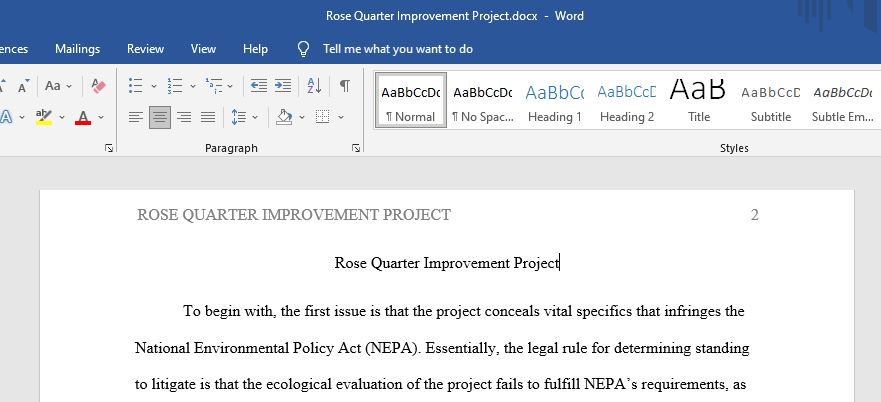Rose Quarter Improvement Project
You are asked to advise 3 nonprofit organizations that oppose the Portland, Oregon, Interstate 5 (I-5) Rose Quarter Improvement Project: No More Freeways, Neighbors for Clean Air, and the Eliot Neighborhood Association.
In conjunction with the Oregon Department of Transportation (“ODOT”), the United States Department of Transportation (“DOT”) and the United States Federal Highway Administration (“FHWA”) completed an Environmental Assessment (“EA”) and issued a Finding of No Significant Impact (“FONSI”) decision for the I-5 Rose Quarter Improvement Project.
To approve the funding for the project, Section 4(f) of the Transportation Act requires that a transportation project is permitted only if there is no prudent and feasible alternative to using a public park, recreation area, or historic site of national, State, or local significance. The project must include all possible planning to minimize harm to the park, recreation area, or historic site if no prudent and feasible alternatives exist.
When completing the Environmental Assessment, the agencies only considered two alternatives: build and no-build. The project will add highway lanes and widen shoulders to increase vehicle capacity and improve smooth traffic flow where three interstates meet at the top traffic bottleneck in Oregon. It will create highway covers on top of I-5 and new crossings over I-5, and one new pedestrian and bicycle bridge along with upgrades to other local streets. The agencies’ analysis of air quality, transportation impacts, noise impacts, climate emissions, and so forth are based on transportation modeling, much of which has been kept from the public’s scrutiny.
The project is in the Albina neighborhood, a historically Black neighborhood of Portland that was divided when I-5 was originally built. Properties in the neighborhood are proposed for the National Register of Historic Places for their significance to PNW Black History. The project is near Harriet Tubman Middle School and its outdoor play area, which will be closer to the highway if the project is completed. The Lillis-Albina Park will be impacted, and the project calls for building a “noise wall” in the park to protect it from highway impacts.
Questions
Identify three (3) legal issues that plaintiffs could raise in a challenge to the agency decisions on the Rose Quarter Improvement Project.
For each legal issue that you identify, articulate rule that you would apply to the issue, then the reasoning for why this legal issue is relevant to the facts of this situation.
For example (do not use this example! You don’t have these facts in the scenario):
Issue: Do the plaintiff organizations have standing to sue DOT, FHWA, and ODOT?
Rule: [State the legal rule for establishing standing to sue]
Reasoning: This issue is relevant because without standing, any case will be dismissed and further claims could not be considered by a court. Because they alleged [fact 1, fact 2] but not [fact 3…], the defendant agencies can challenge the organizations’ standing to sue and the court could dismiss the case….etc
Answer preview:

word limit:484
